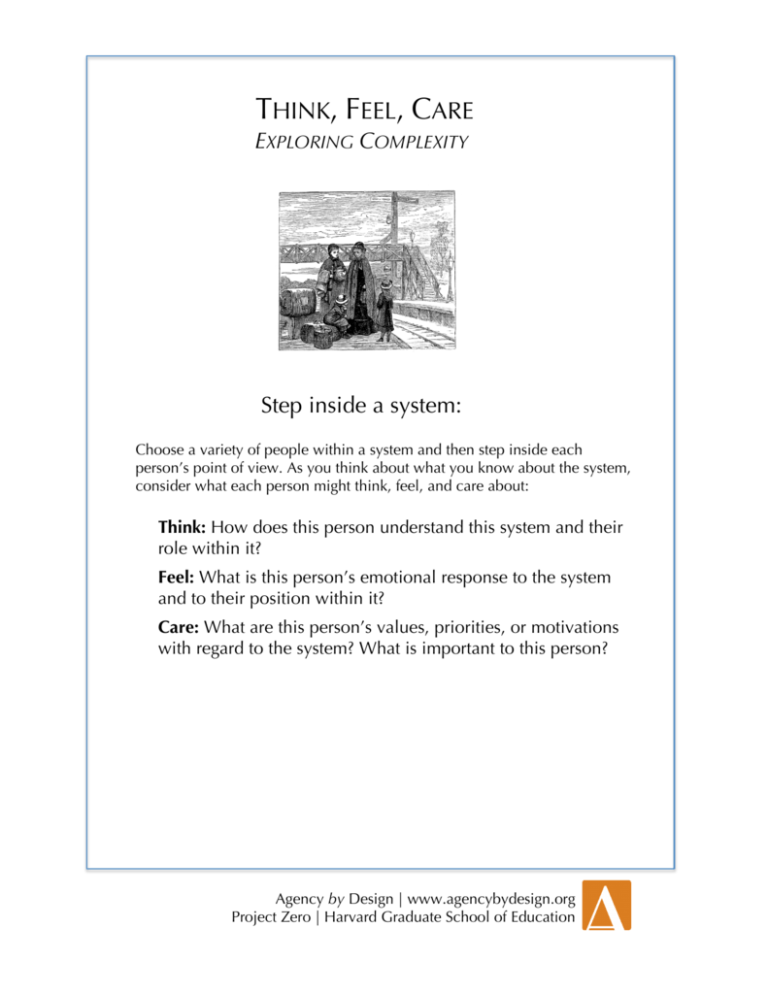Think, Feel, Care - Agency by Design
advertisement

THINK, FEEL, CARE EXPLORING COMPLEXITY Step inside a system: Choose a variety of people within a system and then step inside each person’s point of view. As you think about what you know about the system, consider what each person might think, feel, and care about: Think: How does this person understand this system and their role within it? Feel: What is this person’s emotional response to the system and to their position within it? Care: What are this person’s values, priorities, or motivations with regard to the system? What is important to this person? Agency by Design | www.agencybydesign.org Project Zero | Harvard Graduate School of Education Think, Feel, Care What Kind of Thinking Does This Routine Encourage? This routine encourages students to consider the different and diverse perspectives held by the various people who interact within a particular system. The goal of this routine is to help students understand that the variety of people who participate in a system think, feel, and care differently about things based on their positions in the system. This routine fosters perspective taking, raises questions, and surfaces areas for further inquiry. When and How Can This Routine Be Used? This thinking routine can be used to explore the perspective of any person within a particular system. This routine can be used on its own, or in combination with another routine. Here are some ideas and considerations for putting this thinking routine into practice: • • • • • Working as individuals or in small groups, it may be helpful for you to have students sketch out a small monologue or scene that contains some of the different people who participant in a particular system. They can then assume the role of various people in their system, and act out a small scene, with each student portraying a different person’s perspective. Once students portray a person in their system in one way, ask them how they might portray the same person in an entirely different way. This will prompt your students to understand that even within particular groups of people, there is no one perspective, but rather an array of perspectives that different and unique people may hold. Students should be encouraged to consider how what people think, feel, and care about may be in alignment within a particular system, or misaligned. When misalignments emerge, ask your students how these tensions are dealt with or negotiated within the system? Discussions about unequal power structures within a system may arise. While this routine asks students to step inside the role of a character and to imagine how they may think, feel, and what they might care about from that point of view, it is important to remember that students can never really know and understand someone else’s perspective. When engaging in this thinking routine, it is important for students to push beyond stereotypes and to try to imagine the lived experiences of particular people. Encourage your students to develop specific people to play (e.g., Julia, a migrant worker, John, a used car salesman, and Martin, a Republican senator) as opposed to types of people (e.g., a migrant worker, a used car salesman, and a Republican senator). When perspective taking, students will likely draw on their assumptions about the various types of people represented in their system. As they do so, you may lead students in a discussion that addresses where these assumptions come from. You can encourage students to challenge their assumptions by asking them what they really know about someone else’s perspective, and what they may need to do (e.g., conduct interviews, speak with a grandparent, etc.) in order to find out more about someone else’s perspective. Agency by Design | www.agencybydesign.org Project Zero | Harvard Graduate School of Education






